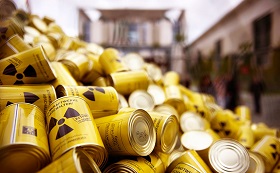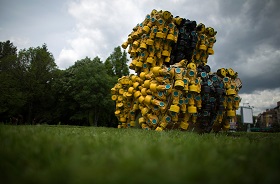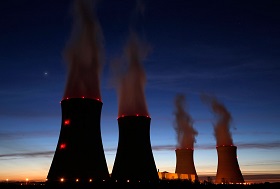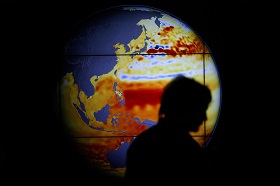Nuclear Waste Storage and Climate Change: What should we expect?
Pool storage where spent nuclear fuel tanks
are unload in baskets under 4 meters of water.
La Hague, western France, April 22, 2015
(votes: 1, rating: 1) |
(1 vote) |
PhD, Post-doctoral Research Fellow WZB Berlin Social Science Center, Research Fellow Cambridge Central Asia Forum
Nuclear power is an energy source that could help to significantly reduce greenhouse gas emissions and reduce the scale of climate change by replacing carbon intensive coal and gas-fired power stations. However, with the production of nuclear energy comes the production of nuclear waste. The waste is produced by a wide variety of processes and can be stored in many different sites around the world. If climate change continues, we should expect more frequent extreme climate events and various environmental changes, which are likely to generate new safety risks for these nuclear waste storage facilities.
Nuclear power is an energy source that could help to significantly reduce greenhouse gas emissions and reduce the scale of climate change by replacing carbon intensive coal and gas-fired power stations. However, with the production of nuclear energy comes the production of nuclear waste. The waste is produced by a wide variety of processes and can be stored in many different sites around the world. If climate change continues, we should expect more frequent extreme climate events and various environmental changes, which are likely to generate new safety risks for these nuclear waste storage facilities. Climate change models project major meteorological and environmental changes, which may significantly affect the safety of existing and future nuclear waste storage facilities. These changes include higher atmospheric temperatures, permafrost degradation, rising sea levels, more frequent and more intensive storms, higher frequency and magnitude of rainfall, and higher maximum wind speed of tropical cyclones. Global warming is likely to be accompanied by changes in floods, slope instabilities and landslides, and extreme coastal high water levels. Rising temperatures and heavy precipitation are also expected to drive geological and geomorphological activity, meaning changes in tectonic plate movement, which could mean more earthquakes, tsunamis and volcanic events. Below, we discuss how these hazards need to be taken into account given current and proposed nuclear waste management policies.
The problem of nuclear waste
Radioactive waste is generated from a range of sources including nuclear power stations (by far the biggest volume), military nuclear programmes, as well as various applications of radioactive materials in medicine, agriculture, industry, and research. Today, in order to avoid the potential detrimental environmental and health impacts of radioactive substances, the waste commonly goes either to near-surface disposal facilities, or to purpose-built interim storage facilities. The chosen options depend on the type of waste — its form (liquid, gas or solid), volume and radioactivity (e.g., low level, intermediate level, and high level). The radionuclides in the waste have different half-lives, ranging from fractions of a second to billions of years, meaning that some waste requires secure long-term storage solutions. Firstly, there is low level waste which has levels of radioactivity that require few extra handling precautions and makes up the vast bulk of radioactive waste. This is typically disposed of in near-surface repositories, in special containers either at ground level in constructed vaults, or in caverns below ground level at depths of tens of metres. There is also intermediate level waste, which requires special storage but is expected to decay over time spans of less than one hundred years. Lastly, high level waste, produced largely by civilian and military nuclear programmes which require special storage, remains radioactive for very long periods of time. Examples of long-lived radionuclides include Uranium-238 with a half-life of 4.5 billion years and Plutonium-239 with a half-life of 24,000 years. Currently, most intermediate and high level waste is kept in interim surface or sub-surface storage facilities, pending the availability of a safe long-term disposal option. These may include (cooling) storage ponds, dry casks or vaults at nuclear plants or centralised facilities. As different countries do not necessarily use the same standards for classifying nuclear waste, particularly low level waste, the total volume is difficult to ascertain. For intermediate and higher level wastes, problems with estimating quantities arise from the lack of public information concerning military nuclear programmes, as well as a lack of records from early nuclear programmes in various countries.
There are two major features that are cause for concern with current nuclear storage facilities, firstly the unsuitability of many storage sites. Currently, for instance, at the Sellafield site in the UK, a multi-billion pound project is underway to remove intermediate level waste from open air storage ponds and move it into steel drums suitable for long term storage. Secondly, most countries have not planned for the long-term storage of their nuclear waste. Only now are plans moving forward in a handful of countries on the design and building of repositories for waste which will last for the hundreds of thousands of years, or longer, required to make the material safe.
The situation in Russia is similar to the rest of the world: over the last half a century, the decision about the final disposal of radioactive waste has been mostly deferred, and Russia has accumulated a large amount of waste (about 500 million tonnes). Russia also deals with a particularly wide range of types of nuclear waste, due to the wide range of different civilian, military and experimental reactors in Russia. Storage and disposal therefore requires a more complex approach due to the interactions between decaying radionuclides. In the near future, many old Soviet industrial sites and nuclear plants will need to be decommissioned, so the amount of nuclear waste will increase. In addition, Russia is among few countries importing nuclear waste — as part of fuel leasing contracts — for further reprocessing, storage or disposal. Russia's nuclear waste is mostly stored in interim storage facilities — on 136 industrial sites and 1466 sites of temporary storage in 43 regions of Russia. (A map of Russia with volumes of nuclear waste by region can be found at link) The waste is stored mostly in purpose-built facilities: aboveground in metal or concrete containers; in metal or concrete storage reservoirs (aboveground or underground) without containers; and open storage pools for liquid waste. Russia's spent nuclear fuel is stored on-site in the reactor storage pools and in storage pools of two companies of the state corporation Rosatom (ФГУП «ГХК» и ФГУП «ПО «Маяк»), on ships servicing the nuclear ice breakers, as well as some coastal facilities.
Short term and intermediate term storage
Given the preference for building nuclear power plants in isolated areas with an ample supply of cooling water, many plants and their on-site waste storage facilities are located close to the coastline, often at low elevations, for example in the UK, where all current nuclear power stations are on coastal or estuary sites, as well as most of the decommissioned ones. Much Soviet and Russian nuclear waste is also stored on the shoreline. Special naval shore bases were built beginning in the 1960s onwards to keep fresh and spent nuclear fuel from nuclear submarines, as well as liquid and solid nuclear waste. One of the major consequences of climate change is the rising sea level along with more frequent extreme storms at sea. This clearly threatens many of these coastal facilities. For example, at the Dounreay nuclear power station in Scotland, a cliff stabilization project is being carried out to prevent erosion below the power station site. In Russia, the shore line bases have been in catastrophic condition for many years, the most notorious example being the base in Andreeva bay in Murmansk oblast. There have been serious leaks from these bases in the past and the situation will only be worsened by climate change. Rosatom is now working to rebuild some naval shore bases and to close the bases which are beyond their service life. The USSR also scuttled a variety of nuclear submarines, reactors and containers with radioactive waste in the Kara sea and the Pacific Ocean. At the moment, there do not appear to be any clear plans for raising or decontaminating these submarines, and higher temperatures and increasing water acidity caused by climate change could lead to faster corrosion of the holding containers.
Long term storage
Due to the presence of long-lived isotopes there is a need to store nuclear waste for very long time periods, up to hundreds of thousands of years. In response to the need for long-term storage, in the 1960s, the USSR and the USA started injecting some liquid waste directly into geological layers. The USA banned the practice in 1984; however, the practice continues in Russia. For example, at the Zheleznogorsk (formerly Krasnoyarsk-26) site, injections have taken place into two porous sandstone beds capped by clays at depths up to 400 metres and the site is licensed to continue until 2020. Currently, many countries are investigating and favour the option of deep geological disposal, i.e. in stable geological formations at depths between 250m and 1000m for mined repositories, or 2000m to 5000m for boreholes. In contrast to the liquid waste injection, the waste is solidified and placed in specially designed containers. In deep geological repositories, nuclear waste is isolated from the environment by a combination of multiple engineered and natural barriers, such as clay, salt or rock; and the facilities are not meant to be actively maintained. The location of deep mined repositories is generally determined by their geological stability and the amount of groundwater flow.
In 2015, the Finnish Government approved the construction of a deep repository — on an island off Finland’s western coast — with plans to seal the repository in around 2120. In the USA, deep geological disposal has been implemented for some intermediate level waste, whereas the plans for using the Yucca Mountain in the Nevada desert as the national repository for spent fuel and high level waste have stalled due to local political resistance. In Canada, the UK, Germany and Japan the search for deep disposal sites has commenced, but the facilities will not open for another few decades. Russia's Rosatom also has plans for the final disposal of some high level and long-life nuclear waste in deep geological formations (more than 500 meters) in Krasnoyarsk kray, between 2021 and 2030, on the basis of an underground research laboratory which would confirm the suitability of the local geological processes.
Longer-term climate change — 10 000 years and more — is believed to be affected by multiple factors including changes in insolation due to cyclical changes in the earth’s orbit around the sun. This means a return of the ice age — with glaciation, development of permafrost, and changing sea levels, which will affect the subsurface environment. Despite the seeming absurdity of considering such long-term climate dynamics, it is important to remember that this time period is comparable to that of radioactive decay of spent nuclear fuel (100,000 years or longer). Therefore, the impact of long-term climate change has also started to be factored into safety analysis of deep geological repositories for nuclear waste.
There are other possibilities for the long-term storage of nuclear waste. For example, it has been suggested that the waste from Bilibino power plant in Chukotka, due to the plant's remoteness and potentially high cost of waste transportation, could be stored in the permafrost [1, 2]. Whilst locating the waste in permafrost could benefit in the short-run from the absence of free water flow and slow chemical reactions, increasing the service period of engineered barriers, the performance of such facility could deteriorate considerably with climate change. This highlights a general issue with repositories. The natural barriers of repositories are influenced by the environment through thermal, hydrological, mechanical and chemical processes. The performance of natural barriers, and the safety of these facilities, may be affected in a number of — often difficult to predict — ways, for example through temperature, changing flow rates and chemistry of groundwater, sea salinity, etc. All of these may change with the climate in the long run, particularly when considering timescales relevant to new ice ages.
Considerations for future policy
The timescales for climate change and some of the nuclear waste management are similar, and climate change related safety risks are important to consider. This needs to be done at the national level, looking at each facility individually, considering different types of waste and varying local conditions. Some of the factors to take into account are temperature, sea level, precipitation, behaviour of glaciers and permafrost. Some countries have started considering climate change risks in their plans for nuclear waste management, for example Sweden and the UK. However, our understanding of future meteorological, geological and geochemical processes driven by climate change (and their impact on the performance of nuclear waste facilities) is at an early stage, and the sector's capacity for response is limited. Any long-term predictions are particularly uncertain, which is an issue for deep geological disposal. There also remains the issue of the reliability of inter-generational knowledge transfer. Mankind has a very poor record of passing knowledge onto next generations and civilisations over the course of thousands of years. Will future generations know where these repositories are and how to safely manage them in case problems arise?
These long-term issues are, at the moment, not at the forefront of policy making. There is still little research into potential climate-driven radioactive contamination. In part, this is due to the greater urgency of current storage problems. In many countries, including Russia, attention is justifiably focused on the poor condition of current facilities and the need for immediate action to avoid environmental disasters in the short run, before any climate-change related changes take place.
(votes: 1, rating: 1) |
(1 vote) |








